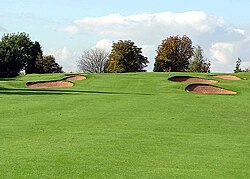|
Golf course turf
 Golf course turf is the grass covering golf courses, which is used as a playing surface in the sport of golf. The grass is usually maintained by a greenskeeper to control weeds, insects with pesticides, plant fungal diseases with fungicides and to introduce nutrients such as nitrogen fertilization. The grass is kept at a constant height by mowing. Nutrient management
Nitrogen is the nutrient required in greatest amount by turfgrass.[1] During an autumn season, rates of nitrogen (N) application should be lowered to consider previous application's residual available nitrate (NO− In the spring, heavy nitrogen applications for the first two months caused changes in color, but the nitrogen response by the grass was not maintained and a decrease in color was found as the growing season progressed. Spring fertilization can increase the tiller numbers of the grass compared to fall fertilization.[3] In the fall, application of nitrogen fertilizer can cause improved color retention and early spring coloration.[3] Year-to-year differences in nitrogen loss during the fall result from differences in temperature and precipitation. Lower levels of nitrogen loss during fall can be found when it was warmer (more plant uptake) and dryer (less loss due to leaching).[2] The quality and color of turf can increase[clarification needed] depending on nitrogen application amount. high rates create darker green turf. There is a positive correlation between high levels of nitrogen fertilizer used on turf and turf quality for any level of wear.[4] Environmental qualityGroundwater and air quality should be considered when applying fertilizer and pesticides to turf. FertilizerTurf growth at the time of nitrogen application affects nitrate (NO− Areas made of sod undergo greater leaching than seeded turf plots.[5] They attributed these differences to less root development in sod which resulted in less uptake of N by the plants. They also found that deep- rather than shallow-rooted grasses absorbed nitrogen more effectively. Additionally, the authors found that nitrogen uptake for loamy sand was greater than a sandy loam because the turf rooting systems were denser in the loam sand. A highly soluble fertilizer, containing nitrogen in its nitrate form, such as ammonium nitrate, can create leaching three to seven times greater than United States Environmental Protection Agency (EPA) limits of (10 ppm) NO3-N during a time of ten to twenty-five days following nitrogen application.[6] Hummel and Waddington, 2001, found that a slow release nitrogen fertilizer application could provide nitrogen over a long duration and keep nitrogen leaching and volatilization[clarification needed] losses to a minimum.[7] A further study demonstrated that after fertilizer application, nitrogen losses exceeded EPA limits.[6] Photoperiod (the length of daylight) affects overall plant uptake. When the length of daylight gets shorter, grass undergoes less photosynthesis and uptakes less nitrogen.[8] To prepare the surface for the following year, high levels of nitrogen application need to be undertaken at the end of the growing season (such as the southern United States[clarification needed]) and increase the risk of nitrate leaching. For example, greater water percolate concentrations of NO3 - N resulted from a late autumn application programme during a New England experiment.[2] PesticidesThe antifungal cyproconazole was marketed as early as 1995 for use on sod farms and golf courses.[9] See also
References
|
Portal di Ensiklopedia Dunia